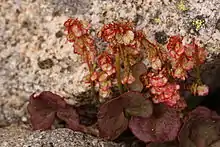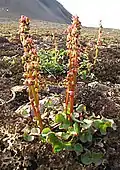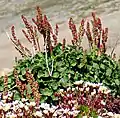Oxyria digyna
Oxyria digyna (mountain sorrel,[1] wood sorrel, Alpine sorrel or Alpine mountain-sorrel) is a species of flowering plant in the buckwheat family (Polygonaceae).[2] It is native to arctic regions and mountainous parts of the Northern Hemisphere.
| Oxyria digyna | |
|---|---|
 | |
| Scientific classification | |
| Kingdom: | Plantae |
| Clade: | Tracheophytes |
| Clade: | Angiosperms |
| Clade: | Eudicots |
| Order: | Caryophyllales |
| Family: | Polygonaceae |
| Genus: | Oxyria |
| Species: | O. digyna |
| Binomial name | |
| Oxyria digyna | |
Description
Mountain sorrel is a perennial plant with a tough taproot that grows to a height of 10 to 30 cm (4 to 12 in). It grows in dense tufts, with stems that are usually unbranched and hairless. Both flowering stems and leaf stalks are somewhat reddish. The leaves are kidney-shaped, somewhat fleshy, on stalks from the basal part of the stem. Flowers are small, green and later reddish, and are grouped in an open upright cluster. The fruit is a small nut, encircled by a broad wing which finally turns red.[3] Forming dense, red tufts, the plant is easily recognized. Oxyria digyna grows in wet places protected by snow in winter. Oxyria (from Greek) means "sour".[2]
Distribution and habitat
Mountain sorrel is common in the tundra of the Arctic. Further south, it has a circumboreal distribution, growing in high mountainous areas in the Northern Hemisphere such as the Alps, the Sierra Nevada, and the Cascade Range. It typically grows in alpine meadows, scree, snow-bed sites and beside streams.[3]
On the coast of Norway, the pollen of this plant has been found in peat bogs that are 12,600 years old, indicating that it must have been one of the first plants to colonise the area after the retreating ice age glaciers.[3]
Deer and elk favor the plant.[4]
Uses
The leaves of mountain sorrel have a sour or fresh acidic taste (due to oxalic acid) and are rich in vitamin C, containing about 36 mg/100 g.[5][6] They can be eaten raw or cooked.[6][7] They were used by the Inuit to prevent and cure scurvy. The plant is important for both insects and larger animals that feed on it in arctic and alpine regions where it occurs.[8]

 Svalbard
Svalbard

References
- "BSBI List 2007". Botanical Society of Britain and Ireland. Archived from the original (xls) on 2015-01-25. Retrieved 2014-10-17.
- Sierra Nevada Wildflowers, Karen Wiese, 2nd ed., 2013, p. 108
- "Mountainsorrel: Oxyria digyna". NatureGate. Retrieved 2013-12-30.
- Reiner, Ralph E. (1969). Introducing the Flowering Beauty of Glacier National Park and the Majestic High Rockies. Glacier Park, Inc. p. 122.
- Vitamin C in the Diet of Inuit Hunters From Holman, Northwest Territories
- Fagan, Damian (2019). Wildflowers of Oregon: A Field Guide to Over 400 Wildflowers, Trees, and Shrubs of the Coast, Cascades, and High Desert. Guilford, CT: FalconGuides. p. 217. ISBN 1-4930-3633-5. OCLC 1073035766.
- Elias, Thomas S.; Dykeman, Peter A. (2009) [1982]. Edible Wild Plants: A North American Field Guide to Over 200 Natural Foods. New York: Sterling. p. 153. ISBN 978-1-4027-6715-9. OCLC 244766414.
- Tolvanen, A., Alatalo, J.M. and Henry, G.H.R. 2004. "Resource allocation patterns in a forb and a sedge in two arctic environments - short-term response to herbivory". – Nordic Journal of Botany 22 (6): 741–747.
External links
 Media related to Oxyria digyna at Wikimedia Commons
Media related to Oxyria digyna at Wikimedia Commons- Jepson Manual Treatment
- Photo gallery
